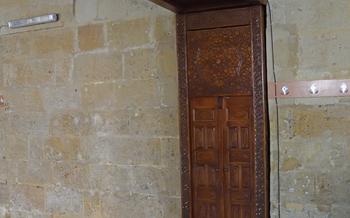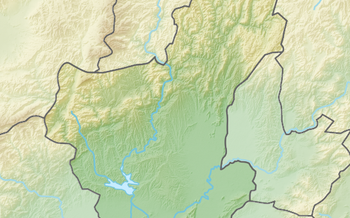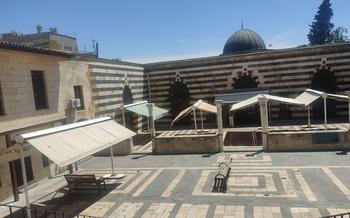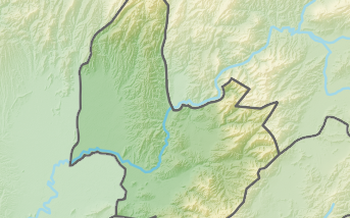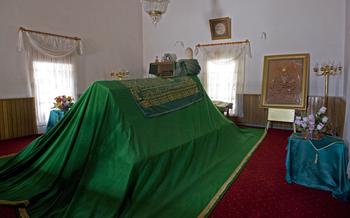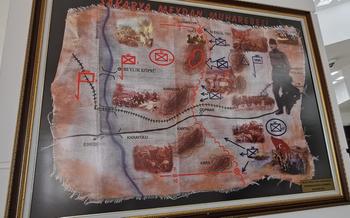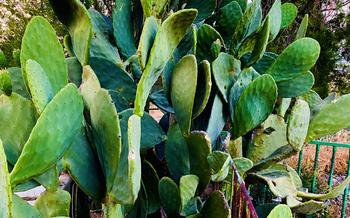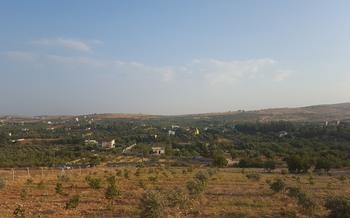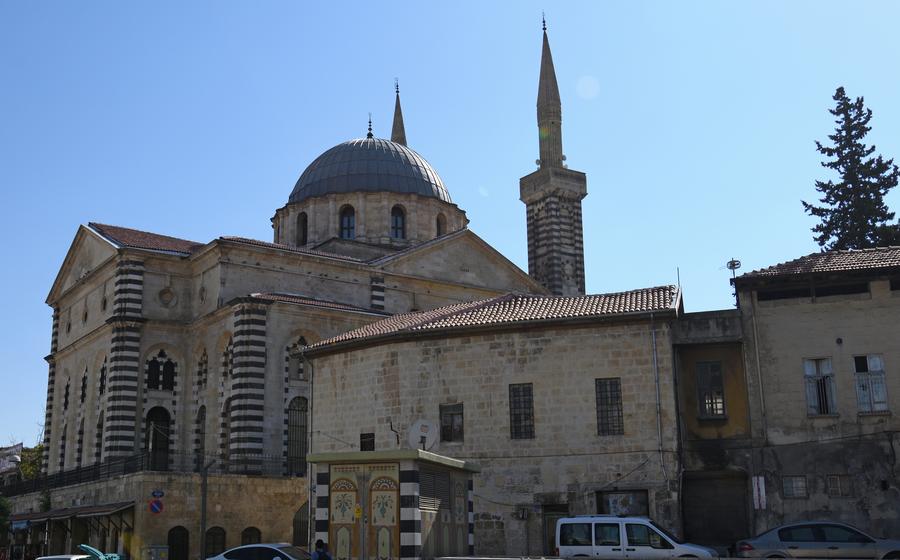
Kurtuluş Mosque in Gaziantep
- History of Kurtuluş Mosque
- Location and Accessibility
- Architectural Features
- Interior Decorations
- Religious Significance
- Cultural Symbolism of the Kurtuluş Mosque
- Visitor Etiquette
- Guided Tours and Accessibility
- Photography and Social Media
- Local Cuisine and Delicacies
- Shopping and Souvenirs:
- Nearby Attractions
- Local Festivals and Events:
- Budget and Cost:
- Insider Tip:
History of Kurtuluş Mosque
The Kurtuluş Mosque, a testament to the grandeur of Ottoman architecture, stands proudly in the heart of Gaziantep. Its construction, initiated by Gaziantep's governor Ali Pasha in 1557, reflects the city's rich heritage and cultural significance. The mosque's design showcases the architectural prowess of the era, with its intricate details, elegant domes, and towering minarets. It has undergone numerous renovations over the years, ensuring its preservation as a symbol of Gaziantep's cultural identity. The mosque's resilience and enduring beauty make it a revered landmark, deeply cherished by the local community.
Location and Accessibility
The Kurtuluş Mosque is conveniently located in the heart of Gaziantep, within the historic city center. The mosque's exact address is Kurtuluş Mahallesi, Kurtuluş Caddesi No:33, Şahinbey/Gaziantep. It is easily accessible by various modes of transportation.
For those using public transportation, the mosque is a short walk from the nearest bus stop, "Kurtuluş Cami," which is served by several bus lines, including the G2 and GAlternatively, visitors can take the metro to the "Gaziantep Castle" station and then walk for approximately 10 minutes to reach the mosque.
If traveling by car, visitors can find ample parking spaces in the vicinity of the mosque. There are several designated parking areas and on-street parking options available.
Before or after visiting the mosque, tourists can explore other nearby attractions such as the Gaziantep Castle, the Zeugma Mosaic Museum, and the Gaziantep Museum of Archaeology. These landmarks are all within walking distance of the Kurtuluş Mosque, making it easy to create a comprehensive itinerary for a day of sightseeing in Gaziantep.
Architectural Features
The Kurtuluş Mosque stands as a testament to the architectural prowess of the Ottoman Empire, showcasing a harmonious blend of Islamic and Seljuk design elements. Its most striking feature is the imposing dome, a symbol of grandeur and divine power that dominates the skyline of Gaziantep. The graceful minarets, with their intricate carvings and slender silhouettes, complement the dome, creating a sense of verticality that draws the eye upward. The mosque's courtyard, a serene oasis amidst the bustling city, features elegant arches and columns that lend a sense of symmetry and order to the space.
The exterior of the mosque is adorned with meticulously crafted tiles, each one a masterpiece of artistry. Geometric patterns and vibrant colors intertwine, creating a mesmerizing visual tapestry that reflects the rich cultural heritage of the region. The mosque's interior is equally impressive, with intricate calligraphy adorning the walls and mihrab. Verses from the Quran, rendered in beautiful script, serve as a reminder of the mosque's religious significance and provide a sense of spiritual connection for worshippers.
Overall, the Kurtuluş Mosque's architectural features embody the essence of Islamic architecture, showcasing a fusion of artistic traditions and symbolizing the city's deep-rooted cultural heritage.
Interior Decorations
The interior of the Kurtuluş Mosque is adorned with intricate decorations that reflect the artistry and craftsmanship of the Ottoman era. The walls are adorned with elegant calligraphy, featuring verses from the Quran and the names of Allah and the Prophet Muhammad. The mihrab, the niche indicating the direction of Mecca, is particularly noteworthy for its intricate tilework and carvings. The mosque's carpets, with their vibrant colors and intricate patterns, add to the overall ambiance and provide a sense of warmth and comfort to the worshippers. The chandeliers, with their delicate glasswork and intricate designs, illuminate the mosque's interior, creating a mesmerizing play of light and shadow. The overall effect of the mosque's interior decorations is one of grandeur and awe, inspiring a sense of devotion and tranquility among the worshippers.
Religious Significance
The Kurtuluş Mosque holds immense religious significance for the Muslim community in Gaziantep, serving as a central place of worship and spiritual guidance. Daily prayers, known as Salat, are performed five times a day, with the mosque's spacious prayer hall accommodating a large congregation. On Fridays, the weekly congregational prayer, Jummah, attracts even more worshippers, creating a vibrant atmosphere of devotion and unity. Throughout the week, the mosque also hosts religious lectures, Quranic recitals, and classes on Islamic studies, fostering a deeper understanding of the faith among the community members. During the holy month of Ramadan, the mosque becomes even more active, with special night prayers, Taraweeh, performed in congregation, creating a spiritual ambiance that resonates throughout the neighborhood. The mosque's religious significance extends beyond its role as a place of worship; it serves as a center for Islamic education and community engagement, strengthening the bonds of faith and fellowship among the people of Gaziantep.
Cultural Symbolism of the Kurtuluş Mosque
The Kurtuluş Mosque is not merely a place of worship but also a symbol of Gaziantep's identity and heritage. It embodies the city's history, values, and traditions, serving as a testament to the profound influence of Islam on the region. The mosque's architectural grandeur and intricate decorations reflect the city's rich cultural heritage, showcasing the blend of Islamic and Anatolian influences that have shaped Gaziantep's unique identity.
Beyond its religious significance, the mosque plays a crucial role in fostering a sense of community and belonging among the people of Gaziantep. It serves as a gathering place for Muslims to come together for prayers, festivals, and other religious and social events. The mosque's presence in the heart of the city reinforces the importance of faith and community in the lives of the local people.
Local legends and stories associated with the mosque further contribute to its cultural significance. One such legend tells the tale of a pious man named Kurtuluş who was instrumental in the mosque's construction. According to the story, Kurtuluş had a dream in which the Prophet Muhammad instructed him to build a mosque on the site where the Kurtuluş Mosque now stands. This legend adds a mystical element to the mosque's history, deepening its connection to the local community.
The Kurtuluş Mosque stands as a proud symbol of Gaziantep's cultural heritage, embodying the city's history, traditions, and values. It serves as a reminder of the enduring influence of Islam in the region and the importance of faith and community in the lives of the local people.
Visitor Etiquette
When visiting the Kurtuluş Mosque, it is important to be respectful of the religious sentiments of the local community. Visitors should dress modestly and avoid wearing revealing or inappropriate clothing. Shoes should be removed before entering the mosque, and visitors are expected to maintain silence and avoid disturbing worshippers. Photography is generally permitted, but visitors should be mindful of not taking photos of people without their consent. It is also important to be aware of the mosque's prayer times and avoid visiting during these periods unless specifically invited by the mosque's staff. By following these guidelines, visitors can ensure that they have a respectful and enriching experience at the Kurtuluş Mosque.
Guided Tours and Accessibility
Visitors interested in learning more about the history, architecture, and significance of the Kurtuluş Mosque can arrange for a guided tour. Guided tours are available in various languages, including English, and can be booked in advance through the mosque's official website or by contacting the mosque's administration.
During the guided tour, visitors will be accompanied by a knowledgeable guide who will provide detailed explanations and insights into the mosque's architectural features, religious significance, and cultural symbolism. The guide will also answer any questions visitors may have and ensure that they have a comprehensive understanding of the mosque's importance.
The mosque is wheelchair accessible, and visitors with disabilities are encouraged to inform the mosque's staff in advance so that necessary arrangements can be made to accommodate their needs. The mosque also offers sign language interpretation services for visitors who are deaf or hard of hearing.
For non-Turkish speakers, translation services are available upon request, ensuring that visitors from all backgrounds can fully appreciate the mosque's significance and history.
Photography and Social Media
When visiting the Kurtuluş Mosque, it is important to be respectful of the religious and cultural significance of the space. Photography is generally allowed, but visitors should be mindful of the privacy of other worshippers and avoid taking photos that could be considered disruptive or disrespectful. It is also important to turn off flash photography and use silent mode on cameras and mobile devices. While sharing experiences on social media can be a great way to connect with others, it is important to do so responsibly. Avoid posting photos or videos of individuals without their consent, and be mindful of the mosque's sanctity when captioning or tagging your posts.
Local Cuisine and Delicacies
After exploring the spiritual and cultural significance of the Kurtuluş Mosque, satisfy your taste buds with the culinary delights of Gaziantep, renowned for its rich cuisine. Stroll through the vibrant streets and discover local restaurants and cafes that offer a tantalizing array of traditional Turkish dishes.
Indulge in mouthwatering kebabs, including the famous Ali Nazik Kebab, where tender lamb pieces are served on a bed of velvety eggplant puree. Savor the flavors of lahmacun, a crispy flatbread topped with minced lamb, tomatoes, and herbs, a local favorite.
For a sweet treat, try the delectable baklava, layers of filo pastry filled with chopped nuts and sweetened with syrup, a testament to Gaziantep's confectionery mastery. Don't miss the opportunity to sample künefe, a delightful dessert made with shredded filo dough, cheese, and syrup, a true masterpiece of Turkish cuisine.
Support local businesses by dining at family-run restaurants and cafes, where you can experience the warmth of Turkish hospitality and immerse yourself in the culinary traditions of Gaziantep. Halal food options are widely available, ensuring that you can savor the local flavors while respecting your dietary preferences.
Shopping and Souvenirs:
After exploring the spiritual beauty of the Kurtuluş Mosque, visitors can immerse themselves in the vibrant shopping scene of Gaziantep. The city is renowned for its traditional Turkish handicrafts, textiles, and culinary delights.
Within walking distance of the mosque, visitors can find the Old Bazaar, a bustling marketplace where they can haggle for unique souvenirs and local products. Here, visitors can find everything from hand-woven carpets and intricate copperware to colorful ceramics and traditional Turkish clothing.
For those seeking culinary treasures, Gaziantep is a haven for food lovers. Visitors can savor the city's signature dishes, such as lahmacun (Turkish pizza) and baklava, at nearby restaurants or cafes.
To support local artisans and businesses, visitors are encouraged to purchase their souvenirs from small shops and stalls rather than large chain stores. Bargaining is customary in Turkish markets, and visitors can often find great deals on high-quality goods.
Nearby Attractions
After exploring the grandeur of Kurtuluş Mosque, visitors can embark on a journey to discover other captivating attractions in Gaziantep. The city boasts a rich tapestry of historical sites, cultural institutions, and natural wonders, each offering a unique glimpse into the city's heritage and vibrant spirit.
A short walk from the mosque, visitors can delve into the fascinating history of Gaziantep at the Zeugma Mosaic Museum. Home to an awe-inspiring collection of ancient mosaics, this museum showcases the artistic prowess of the Roman and Byzantine civilizations. The intricate designs and vibrant colors of these mosaics transport visitors back in time, offering a glimpse into the lives and beliefs of people who inhabited this region centuries ago.
For those seeking a taste of Gaziantep's culinary delights, a visit to the Gaziantep Zeugma Cuisine Museum is a must. This unique museum celebrates the city's rich culinary heritage, showcasing traditional cooking methods, recipes, and ingredients that have been passed down through generations. Visitors can learn about the significance of certain dishes, sample local delicacies, and even participate in interactive cooking demonstrations.
Nature enthusiasts will find solace in the Gaziantep Botanik Park, a sprawling haven of tranquility located on the outskirts of the city. This beautiful park features a diverse collection of plants and flowers, creating a vibrant tapestry of colors and scents. Visitors can stroll along the winding paths, admire the meticulously landscaped gardens, and enjoy a picnic surrounded by nature's beauty.
To experience the vibrant energy of Gaziantep, visitors should explore the city's bustling markets and bazaars. The Old Bazaar, with its labyrinthine streets and colorful stalls, offers a glimpse into the city's trading traditions. Here, visitors can bargain for unique handicrafts, savor the aromas of freshly ground spices, and indulge in the sweetness of traditional Turkish delights.
Gaziantep's rich cultural heritage is further showcased at the Gaziantep City Museum, which houses a collection of artifacts, photographs, and documents that tell the story of the city's past. Visitors can learn about Gaziantep's role in various historical events, admire traditional costumes and textiles, and gain insights into the lives of the people who have shaped the city's identity.
These are just a few of the many attractions that await visitors in Gaziantep. With its blend of history, culture, and natural beauty, this vibrant city offers an unforgettable experience for travelers seeking an authentic and enriching journey.
Local Festivals and Events:
Gaziantep is renowned for its vibrant cultural scene and hosts many festivals and events throughout the year. The city celebrates its rich heritage and traditions with events like the Gaziantep International Film Festival, the Gaziantep Biennial, and the Gaziantep Gastronomy Festival. Visitors interested in Islamic culture can attend the Mevlana Festival, which commemorates the life and teachings of the famous Sufi poet Rumi. The festival features traditional music, dance, and whirling dervish performances. The Gaziantep Ramadan Festival is another significant event, showcasing the city's culinary delights and offering a unique opportunity to experience the local traditions during the holy month. These festivals and events provide visitors with a chance to immerse themselves in Gaziantep's cultural tapestry and create memorable experiences beyond their visit to the Kurtuluş Mosque.
Budget and Cost:
Visiting the Kurtuluş Mosque is free of charge, as it is a religious site open to the public. However, there may be additional costs associated with your trip to Gaziantep. Transportation within the city is affordable, with options like buses and taxis readily available. Accommodation costs vary depending on your preferences and budget. Consider staying in local guesthouses or budget hotels for a more economical option. Food expenses can be managed by sampling local street food or dining at affordable restaurants. Look for local markets to purchase souvenirs and handicrafts at reasonable prices. By planning your trip wisely, you can explore Gaziantep, including the Kurtuluş Mosque, without breaking the bank.
Insider Tip:
For a truly immersive experience, visit the Kurtuluş Mosque during the holy month of Ramadan. During this special time, the mosque comes alive with a festive atmosphere, as Muslims from all over Gaziantep gather for prayers and celebrations. Visitors are welcome to join the nightly Taraweeh prayers, which are followed by communal meals and gatherings. This is a unique opportunity to observe Islamic traditions and experience the vibrant spiritual energy of the mosque during this sacred month.
